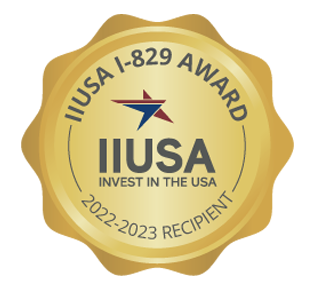FAQ
What is the EB-5 Program?
The EB-5 Program is a permanent residency program administered by the United States Citizenship and Immigration Services (USCIS). This program is known as EB-5 for the «employment-based fifth preference» visa, which grants permanent residency (commonly referred to as a green card). Its primary purpose is to stimulate the U.S. economy by encouraging foreign capital investment in commercial enterprises that create or preserve U.S. jobs. Under the EB-5 Program, each investor is required to demonstrate that at least ten (10) permanent full-time jobs were created or preserved as a result of the EB-5 investment, with a minimum investment of $1,050,000, or $800,000 if the funds are invested in certain high-unemployment or rural areas.
In 1992, Congress enhanced the economic impact of the EB-5 Program by permitting the designation of regional centers to pool EB-5 capital from multiple foreign investors for investment in economic development projects approved by USCIS within a defined geographic region. This measure has been tremendously successful, and today, approximately 95% of all EB-5 capital is raised and invested by regional centers.
Through the EB-5 Program, foreign investors and their eligible family members are offered the possibility of lawful permanent residence in the United States. The EB-5 visa provides a direct and predictable path to achieving U.S. permanent residence (green card) and, in the future, U.S. citizenship.
What are the basic eligibility requirements for the EB-5 visa?
The basic eligibility requirements for the EB-5 visa include:
- Investment Amount: Invest at least $800,000 in a Targeted Employment Area (TEA) or $1,050,000 in a non-TEA.
- Job Creation: The investment must create or preserve at least 10 permanent full-time jobs for qualifying U.S. workers within time limits defined by the USCIS.
- At-Risk Investment: The invested capital must be «at-risk» for the purpose of generating a return on the capital. There is no guaranteed financial return.
- Lawful Source and Path of Funds: Prove that the investment funds come from, and through, a legal and traceable source and path, such as income, sale of property, inheritance, or a gift.
- Conditional Permanent Residency: Initially, investors and their families receive conditional green cards, which will then be converted into permanent green cards when the investment and job creation requirements are met.
Meeting these criteria is essential to qualify for the EB-5 Program. Investors are encouraged to discuss with their immigration attorney to ensure EB-5 visa eligibility.
What is the minimum investment amount for the EB-5 Program?
To qualify for an EB-5 Visa, a foreign investor needs to invest at least $800,000 in a Targeted Employment Area (TEA) or $1,050,000 in a non-TEA. Whether a census tract qualifies as a TEA, rural, or non-TEA is determined by statistical data issued by the relevant state departments and, ultimately, approved by the USCIS in I-956F and/or I-526E adjudication.
What is a Targeted Employment Area (TEA) and non-TEA?
A Targeted Employment Area (TEA) can be, at the time of investment, either:
- A rural area; or
- An area that has experienced high unemployment (defined as at least 150% of the national average unemployment rate).
A rural area is any area other than an area within a metropolitan statistical area (MSA) (as designated by the Office of Management and Budget) or within the outer boundary of any city or town having a population of 20,000 or more according to the most recent decennial census of the United States.
A high-unemployment area consists of the census tract or contiguous census tracts in which the new commercial enterprise is principally doing business, which may include any or all directly adjacent census tracts, if the weighted average unemployment for the specified area, based on the labor force employment measure for each tract, is 150% of the national unemployment average.
Also, a regional center investor may choose to invest in a new commercial enterprise engaged in an infrastructure project. An infrastructure project is a capital investment project in a filed or approved business plan, which is administered by a governmental entity (such as a Federal, State, or local agency or authority) that is the job-creating entity contracting with a regional center or new commercial enterprise to receive capital investment under the EB-5 Program from foreign investors or the new commercial enterprise as financing for maintaining, improving, or constructing a public works project of these set-aside visas that go unused are held in the same set-aside category for one more fiscal year. After the second fiscal year, any remaining unused immigrant visas in these set-aside categories are released to the unreserved EB-5 visa numbers during the third fiscal year.
The majority of EB-5 investments are directed towards Targeted Employment Areas (TEAs), which encompass rural or high-unemployment communities that welcome new capital investment intended to strengthen the economic viability and vitality of that community and region.
Projects that fall outside of the areas or project types mentioned above are deemed as non-TEA projects and will be subject to $1,050,000 minimum investment level.
What is the specific amount of the EB-5 regional center administrative fee, and what does it cover?
Currently, Golden Gate Global’s administrative fees range from $65,000 to $70,000, depending on the offering. The amount, purpose, and use of the administrative fee are disclosed in the offering documents, and includes the following purposes:
- Regional Center compliance and processing fees
- Fund preparation and operational costs (legal, accounting, administration, etc.)
- Fund administration setup
- Marketing and promotional costs
- Investor Know Your Client (KYC) compliance and due diligence
- IRS, SEC, and USCIS compliance
- Recordkeeping and reporting
What additional EB-5 costs need to be considered?
As of January 2024, the applicable fees are as follows. Please note that there are potential increases to the filing fees as announced by USCIS on or around January 31, 2024, to be effectuated on April 1, 2024. Accordingly, please refer to the USCIS website for the most recent fee schedule.
- Immigration attorney fees
- USCIS filing fee for the I-526E: $3,675*
- Certified translation services fee
- USCIS filing fee for the I-829: $3,750*
* After the I-526E petition is approved for the conditional green card, there might be other USCIS fees during the process, depending on the family members involved. As USCIS will adjust filing fees occasionally, please visit www.uscis.gov for the most current fees.
What is the EB-5 investment duration? When will the EB-5 investment be repaid to the investor?
Can the investment funds be borrowed for the EB-5 Program?
Yes, it is possible to use borrowed funds for the EB-5 Program. The borrowed funds must come from a lawful and traceable source. You must be able to demonstrate the legitimacy of the source of the borrowed funds to USCIS. Please check with your immigration attorney regarding source and path of funds-related questions.
To learn more about possible sources of funds for EB-5 visa, please read the article.
Which services do I need for the EB-5 process?
In addition to any financial and project due diligence the investor may want to conduct on the project documents, the investors should also retain an immigration attorney for their EB-5 related petitions. Furthermore, investors may consider additional services to assist their immigration process. These services may involve separate fees.
Additional services and expenses might include:
- Translation and interpretation services
- Tax planning
- Other legal, tax, or accounting preparations
- Investor’s bank wire fees
- Any services regarding settling in the United States, including home buying and education planning
- Wealth management services
If you would like to learn more about these additional services, please let Golden Gate Global know.
What if USCIS does not approve my I-526E petition?
With the guidance of your immigration attorney and assistance of Golden Gate Global (where possible and applicable), the investor has the opportunity to appeal the decision. In the case of a final denial of your I-526E petition, the investor’s capital investment may be refundable. Please refer to the specific offering documents for details on denial repayment terms.
What happens once I complete my EB-5 investment and my funds are returned?
Prior to the repayment of funds, Golden Gate Global will contact you to provide more information about its affiliated investment platform and reinvestment opportunities.
To learn more about EB-5 repayments, please read the article.
What is Form I-526E (Immigrant Petition by Regional Center Investor)?
Form I-526E, officially titled the «Immigrant Petition by Regional Center Investor» is a crucial document in the EB-5 Program. This form is used by foreign nationals seeking to obtain a U.S. conditional green card through investment in line with the terms and conditions of the EB-5 Program. When an investor submits a Form I-526E, they are essentially petitioning the USCIS to confirm their eligibility for the EB-5 Program. Once USCIS approves the I-526E petition, the investor can proceed with the process paving the way for their lawful entry and residence (study/work/travel) in the United States.
What is Form I-829 (Petition by Investor to Remove Conditions on Permanent Resident Status)?
Form I-829, officially titled the «Petition by Investor to Remove Conditions on Permanent Resident Status» is another significant document in the EB-5 Program. This form is used by individuals who have previously obtained conditional U.S. permanent residency through the EB-5 Program through Form I-526/Form I-526E to request the removal of those conditions. By filing Form I-829, the investor is essentially demonstrating to the USCIS that they have met the necessary investment and job creation requirements and that their investment has resulted in the creation of the required jobs, supported by relevant evidentiary documents. Once USCIS approves Form I-829, the investor’s conditional permanent residency status is removed, and they become a U.S. permanent resident without any further EB-5 related conditions.
What is Form I-485 (Application to Register Permanent Residence or Adjust Status)?
Form I-485, officially titled the «Application to Register Permanent Residence or Adjust Status» is a form used in the United States immigration process. It is primarily used by individuals who are already in the United States on another non-resident status and wish to apply for lawful permanent resident status, commonly known as a green card, without the need to go through the U.S. embassy or consulate in their home country.
Form I-485 is used for various immigration categories, including family-based, employment-based, asylum, and the adjustment of status for certain individuals, such as those with approved Form I-526E petitions in the EB-5 Program. This form is a step in the process of transitioning from a temporary visa holder to a lawful permanent resident of the United States.
An important concept introduced by the EB-5 Reform and Integrity Act of 2022 (commonly known as the RIA) is the ability of an EB-5 investor to file a Form I-485 petition before the initial EB-5 petition (Form I-526E) is approved, provided a visa is «available». For new investors, this means a Form I-485 can be filed concurrently (i.e., at the same time) as the Form I-526E. For existing investors, this means a Form I-485 can be filed before the pending Form I-526 is approved. Included with a Form I-485 petition are applications for work authorization (Form I-765) and for advance parole (Form I-131) that allow the applicant to travel internationally during the time the Form I-485 is pending. The ability to remain in the United States, lawfully work upon receipt of the employment authorization document (EAD), and have children attend public school, during the time in which the EB-5 petition is pending, is beneficial.
Disclaimer
GGG does not provide immigration, tax, legal, compliance or accounting advisory services; investors should consult an immigration, tax, legal, compliance or accounting advisor before engaging transactions.


